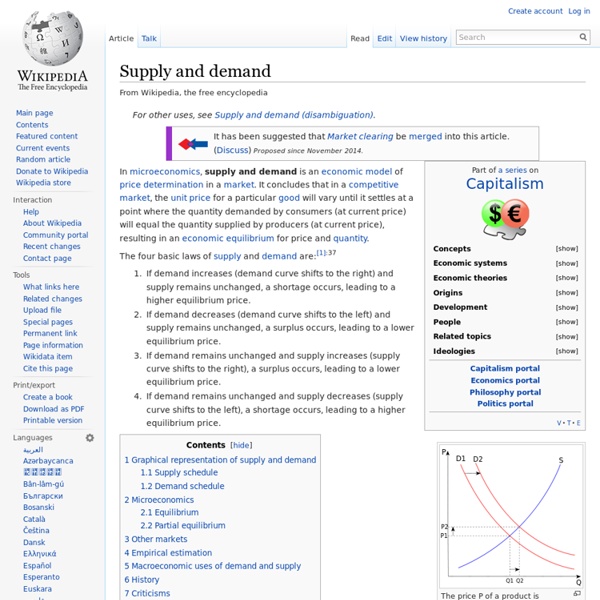Supply and demand

Microeconomics
This is in contrast to macroeconomics, which involves the "sum total of economic activity, dealing with the issues of growth, inflation, and unemployment."[2] Microeconomics also deals with the effects of national economic policies (such as changing taxation levels) on the aforementioned aspects of the economy.[4] Particularly in the wake of the Lucas critique, much of modern macroeconomic theory has been built upon 'microfoundations'—i.e. based upon basic assumptions about micro-level behavior. Assumptions and definitions[edit] Microeconomic theory progresses by defining a competitive budget set which is a subset of the consumption set. The utility maximization problem is the heart of consumer theory. The utility maximization problem is a simple constrained optimization problem in which an individual seeks to maximize utility subject to a budget constraint. The theory of supply and demand usually assumes that markets are perfectly competitive. Microeconomic topics[edit] Monopoly[edit]
Economics
For a topical guide to this subject, see Outline of economics. Economics is the social science that studies the behavior of individuals, households, and organizations (called economic actors, players, or agents), when they manage or use scarce resources, which have alternative uses, to achieve desired ends. Agents are assumed to act rationally, have multiple desirable ends in sight, limited resources to obtain these ends, a set of stable preferences, a definite overall guiding objective, and the capability of making a choice. There exists an economic problem, subject to study by economic science, when a decision (choice) has to be made by one or more resource-controlling players to attain the best possible outcome under bounded rational conditions. In other words, resource-controlling agents must maximize value subject to the constraints imposed by the information the agents have, their cognitive limitations, and the finite amount of time they have to make and execute a decision. J.
Macroeconomics
Circulation in macroeconomics. Macroeconomics (from the Greek prefix makro- meaning "large" and economics) is a branch of economics dealing with the performance, structure, behavior, and decision-making of an economy as a whole, rather than individual markets. This includes national, regional, and global economies.[1][2] With microeconomics, macroeconomics is one of the two most general fields in economics. While macroeconomics is a broad field of study, there are two areas of research that are emblematic of the discipline: the attempt to understand the causes and consequences of short-run fluctuations in national income (the business cycle), and the attempt to understand the determinants of long-run economic growth (increases in national income). Macroeconomic models and their forecasts are used by governments to assist in the development and evaluation of economic policy. Basic macroeconomic concepts[edit] Output and income[edit] Unemployment[edit] Main article: Unemployment IS–LM[edit] 1.
Related:
Related:



